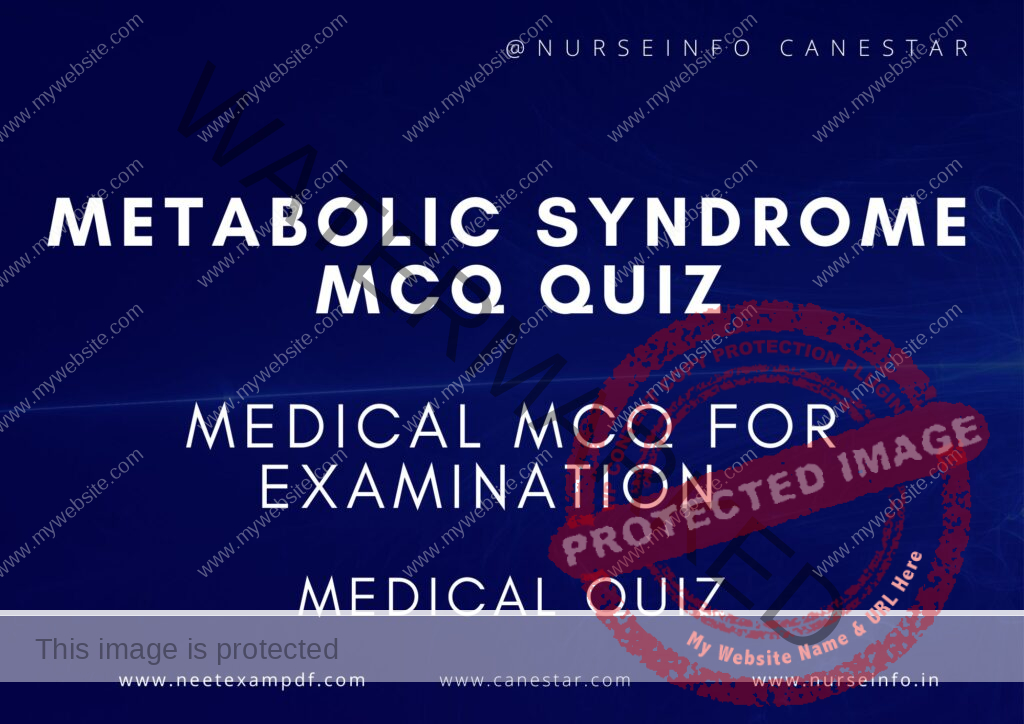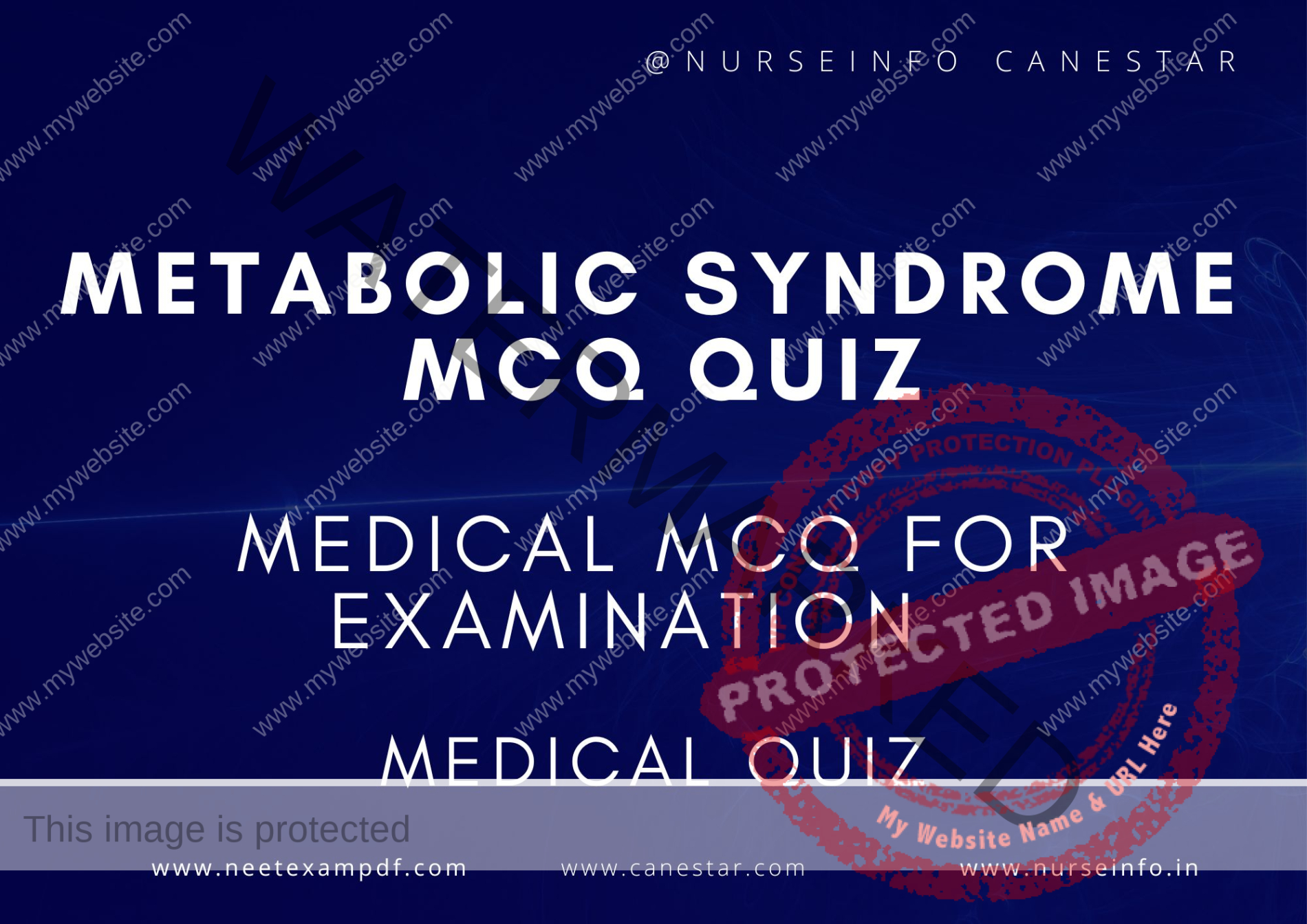MULTIPLE CHOICE QUESTIONS ON METABOLIC SYNDROME QUIZ – MCQS WITH RATIONALE ANSWER – METABOLIC DISORDERS OR SYNDROME MCQ QUESTIONS WITH RATIONALE
MCQ FOR METABOLIC SYNDROME OR DISORDERS QUIZ
These mcqs are prepared exclusively for medical professionals for exam preparation. MCQ is helpful to remember the concept on metabolic syndrome mcq quiz. This multiple choice questions are helpful for preparation for DHA, PROMETRIC, MOH, HAAD, NCLEX, Medical, NEET and Nursing EXAMINATION
METABOLIC SYNDROME OR DISORDERS MCQ QUIZ
MCQs on Metabolic Disorders
Which of the following is the most common cause of hyperthyroidism?
A) Hashimoto’s thyroiditis
B) Graves’ disease
C) Thyroid cancer
D) Subacute thyroiditis
Answer: B) Graves’ disease
Rationale: Graves’ disease is an autoimmune disorder and the most common cause of hyperthyroidism. It results from the production of antibodies that stimulate the thyroid gland to produce excessive amounts of thyroid hormone.
What is the primary defect in Type 1 Diabetes Mellitus?
A) Insulin resistance
B) Insulin deficiency
C) Excessive insulin production
D) Impaired insulin signaling
Answer: B) Insulin deficiency
Rationale: Type 1 Diabetes Mellitus is characterized by the autoimmune destruction of insulin-producing beta cells in the pancreas, leading to an absolute deficiency of insulin.
Which enzyme deficiency is responsible for phenylketonuria (PKU)?
A) Tyrosinase
B) Phenylalanine hydroxylase
C) Glucose-6-phosphatase
D) Galactose-1-phosphate uridyltransferase
Answer: B) Phenylalanine hydroxylase
Rationale: Phenylketonuria (PKU) is caused by a deficiency of the enzyme phenylalanine hydroxylase, which leads to the accumulation of phenylalanine and its metabolites in the body.
Which of the following is a characteristic feature of Cushing’s syndrome?
A) Hyperpigmentation
B) Moon face
C) Weight loss
D) Hypotension
Answer: B) Moon face
Rationale: Cushing’s syndrome is characterized by hypercortisolism, leading to features such as a rounded face (“moon face”), central obesity, and muscle weakness.
Which metabolic disorder is associated with the accumulation of glycogen in tissues?
A) Gaucher disease
B) McArdle disease
C) Pompe disease
D) Tay-Sachs disease
Answer: C) Pompe disease
Rationale: Pompe disease is a glycogen storage disorder caused by a deficiency of the enzyme acid alpha-glucosidase, leading to the accumulation of glycogen in various tissues, particularly muscles.
What is the underlying defect in familial hypercholesterolemia?
A) Increased cholesterol absorption
B) Decreased cholesterol synthesis
C) Mutations in the LDL receptor
D) Overproduction of triglycerides
Answer: C) Mutations in the LDL receptor
Rationale: Familial hypercholesterolemia is an inherited disorder caused by mutations in the gene encoding the LDL receptor, leading to reduced clearance of LDL cholesterol from the blood.
Which amino acid is deficient in maple syrup urine disease (MSUD)?
A) Tyrosine
B) Phenylalanine
C) Leucine
D) Methionine
Answer: C) Leucine
Rationale: Maple syrup urine disease (MSUD) is caused by a deficiency in the branched-chain alpha-keto acid dehydrogenase complex, leading to the accumulation of branched-chain amino acids such as leucine, isoleucine, and valine.
What is the primary biochemical defect in Tay-Sachs disease?
A) Accumulation of sphingomyelin
B) Accumulation of glucocerebroside
C) Deficiency of hexosaminidase A
D) Deficiency of galactocerebrosidase
Answer: C) Deficiency of hexosaminidase A
Rationale: Tay-Sachs disease is caused by a deficiency of the enzyme hexosaminidase A, leading to the accumulation of GM2 ganglioside in the nervous system.
Which disorder is characterized by the accumulation of homogentisic acid?
A) Alkaptonuria
B) Homocystinuria
C) Maple syrup urine disease
D) Phenylketonuria
Answer: A) Alkaptonuria
Rationale: Alkaptonuria is caused by a deficiency of the enzyme homogentisate oxidase, leading to the accumulation of homogentisic acid, which can cause darkening of urine and ochronosis (bluish-black pigmentation) in connective tissues.
What is the primary treatment for phenylketonuria (PKU)?
A) Low-tyrosine diet
B) Low-phenylalanine diet
C) High-protein diet
D) High-phenylalanine diet
Answer: B) Low-phenylalanine diet
Rationale: The primary treatment for phenylketonuria (PKU) is a diet low in phenylalanine to prevent the buildup of phenylalanine and its toxic metabolites in the body.
Which metabolic disorder is characterized by the presence of “cherry-red spots” in the retina?
A) Gaucher disease
B) Niemann-Pick disease
C) Tay-Sachs disease
D) Fabry disease
Answer: C) Tay-Sachs disease
Rationale: Tay-Sachs disease is characterized by the accumulation of GM2 ganglioside in the retina, leading to the appearance of “cherry-red spots.”
What enzyme is deficient in Gaucher disease?
A) Sphingomyelinase
B) Hexosaminidase A
C) Glucocerebrosidase
D) Galactosylceramidase
Answer: C) Glucocerebrosidase
Rationale: Gaucher disease is caused by a deficiency of the enzyme glucocerebrosidase, leading to the accumulation of glucocerebroside in cells.
What is the hallmark of Lesch-Nyhan syndrome?
A) Hyperuricemia
B) Hypoglycemia
C) Hyperlipidemia
D) Hypocalcemia
Answer: A) Hyperuricemia
Rationale: Lesch-Nyhan syndrome is caused by a deficiency of the enzyme hypoxanthine-guanine phosphoribosyltransferase (HGPRT), leading to hyperuricemia and severe neurological and behavioral abnormalities.
Which disorder is associated with impaired conversion of galactose to glucose?
A) Galactosemia
B) Glycogen storage disease
C) Fructose intolerance
D) Lactose intolerance
Answer: A) Galactosemia
Rationale: Galactosemia is a disorder caused by deficiencies in enzymes involved in converting galactose to glucose, leading to the accumulation of galactose and its metabolites.
Which of the following is a common symptom of hyperthyroidism?
A) Weight gain
B) Bradycardia
C) Heat intolerance
D) Hypotension
Answer: C) Heat intolerance
Rationale: Hyperthyroidism increases metabolic rate, leading to symptoms such as heat intolerance, weight loss, and tachycardia.
Which disorder is characterized by muscle cramps and myoglobinuria after exercise?
A) McArdle disease
B) Pompe disease
C) Tay-Sachs disease
D) Phenylketonuria
Answer: A) McArdle disease
Rationale: McArdle disease, or glycogen storage disease type V, is caused by a deficiency of muscle phosphorylase, leading to impaired glycogen breakdown in muscles and resulting in muscle cramps and myoglobinuria after exercise.
Which hormone is primarily responsible for lowering blood glucose levels?
A) Glucagon
B) Cortisol
C) Insulin
D) Epinephrine
Answer: C) Insulin
Rationale: Insulin, produced by the beta cells of the pancreas, is the primary hormone responsible for lowering blood glucose levels by facilitating the uptake of glucose into cells.
Which metabolic disorder is screened for in newborns using the Guthrie test?
A) Phenylketonuria
B) Galactosemia
C) Cystic fibrosis
D) Hypothyroidism
Answer: A) Phenylketonuria
Rationale: The Guthrie test is a bacterial inhibition assay used to screen for phenylketonuria (PKU) in newborns by detecting elevated levels of phenylalanine in the blood.


